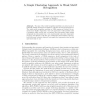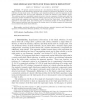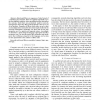10602 search results - page 2 / 2121 » Weakly Useful Sequences |
WABI
2007
Springer
14 years 1 months ago
2007
Springer
The aim of the motif recognition problem is to detect a set of mutually similar subsequences within a collection of biological sequences. The weak motif recognition problem on DNA ...
CVPR
2009
IEEE
15 years 3 months ago
2009
IEEE
The goal of this work is to automatically learn a large
number of British Sign Language (BSL) signs from TV
broadcasts. We achieve this by using the supervisory information
avai...
SIAMAM
2002
13 years 7 months ago
2002
Abstract. We present numerical solutions of a two-dimensional Riemann problem for the unsteady transonic small disturbance equations that provides an asymptotic description of the ...
TIME
2009
IEEE
14 years 2 months ago
2009
IEEE
—Rule-based filters are sequences of rules formed of a condition and a decision. Rules are applied sequentially up to the first fulfilled condition, whose matching decision de...
CVPR
2008
IEEE
14 years 9 months ago
2008
IEEE
Online boosting methods have recently been used successfully for tracking, background subtraction etc. Conventional online boosting algorithms emphasize on interchanging new weak ...



